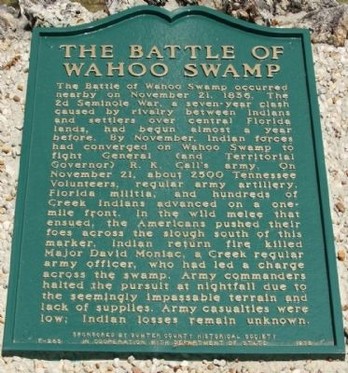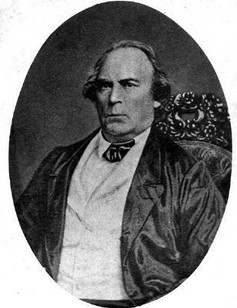The Battle of Wahoo Swamp
Introduction
Text-to-speech Audio
The Battle of Wahoo Swamp occurred on November 21, 1836, during the Second Seminole War. This seven-year war was waged between the Seminole and Floridian settlers over control of central Florida. This particular battle was between General R.K. Call's army and several hundred Seminole Indians. The army was able to push the Seminole Indians south owing to superior firepower, but they were unable to pursue the Seminole Indians due to terrain and lack of supplies, thus forcing General Call to retreat. American forces suffered few casualties during the battle while it is unknown how many casualties the Seminole endured in the battle.
Images
By Mike Stroud 2011, The Battle of Wahoo Swamp Marker

General R.K. Call

Backstory and Context
Text-to-speech Audio
The Second Seminole War started in 1835 and was set in motion by President Andrew Jackson's passing of the Indian Removal Act of 1830, giving the military power to forcibly remove Indians West of the Mississippi. Although this went against the previous treaty that had been formed after the First Seminole War, it was evident that neither side fully abided by the stipulations within that treaty. In the years that followed the Indian Removal Act, there were several attempts in diplomatically reaching out to the Seminoles but The Treaty of Fort Gibson that came from this work seemed to be a work of coercion and Seminole leaders denied having agreed to leave their lands.
In 1834 General Thompson informed the Indians in Florida that the would be removed by military means after learning that they had no intention of leaving Florida. In response, Osceola emerged as a leader among the Seminoles and on December 28, 1835, more than 100 American soldiers were ambushed by Seminole forces and all but three were killed. This event was dubbed The Dade Massacre and marked the start of the Second Seminole War. On this same day, Osceola killed General Thompson.
The Battle of Wahoo Swamp occurred on November 26th, 1836 when General Call's forces consisting of 2,500 regular troops and Tennessee militia marched on an encampment of approximately 600 Seminole Indians and African Americans who had joined with the Seminole in previous years. The Seminole fought ferociously during the onslaught and killed Major David Moniac during the fight. The Seminole's engaged the American forces from one side of a creek and due to this advantage in terrain were able to prevail and force the American Troops to retreat. General Call did not want his troops to be halted in the muddy creek nor did he have the provisions to continue the battle.
In October of 1837, General Thomas Jesup set up a false peace negotiation in order to capture Osceola and dozens of his followers. The following December, General Taylor was able to lead a 1,000 men against a reported Seminole encampment at Lake Okeechobee. The devastating battle caused a Seminole withdraw. The final major battle of the war was in January of 1838 at the Battle of the Loxahatchee River. The remainder of the war consisted of small bands of Seminoles attempting to avoid being forced across the Mississippi River. The Second Seminole War officially ended in 1842.
In 1834 General Thompson informed the Indians in Florida that the would be removed by military means after learning that they had no intention of leaving Florida. In response, Osceola emerged as a leader among the Seminoles and on December 28, 1835, more than 100 American soldiers were ambushed by Seminole forces and all but three were killed. This event was dubbed The Dade Massacre and marked the start of the Second Seminole War. On this same day, Osceola killed General Thompson.
The Battle of Wahoo Swamp occurred on November 26th, 1836 when General Call's forces consisting of 2,500 regular troops and Tennessee militia marched on an encampment of approximately 600 Seminole Indians and African Americans who had joined with the Seminole in previous years. The Seminole fought ferociously during the onslaught and killed Major David Moniac during the fight. The Seminole's engaged the American forces from one side of a creek and due to this advantage in terrain were able to prevail and force the American Troops to retreat. General Call did not want his troops to be halted in the muddy creek nor did he have the provisions to continue the battle.
In October of 1837, General Thomas Jesup set up a false peace negotiation in order to capture Osceola and dozens of his followers. The following December, General Taylor was able to lead a 1,000 men against a reported Seminole encampment at Lake Okeechobee. The devastating battle caused a Seminole withdraw. The final major battle of the war was in January of 1838 at the Battle of the Loxahatchee River. The remainder of the war consisted of small bands of Seminoles attempting to avoid being forced across the Mississippi River. The Second Seminole War officially ended in 1842.
Sources
“The Battle of Wahoo Swamp Historical Marker.” Historical Marker, 16 June 2016, www.hmdb.org/marker.asp?marker=41679.
Bauer, Patricia. “Second Seminole War.” Encyclopædia Britannica, Encyclopædia Britannica, Inc., 16 Apr. 2018, www.britannica.com/event/Second-Seminole-War.
“From West Point To Wahoo Swamp: The Career Of Cadet David Moniac, Class Of 1822.” NMAI Magazine, www.americanindianmagazine.org/story/west-point-wahoo-swamp-career-cadet-david-moniac-class-1822.
